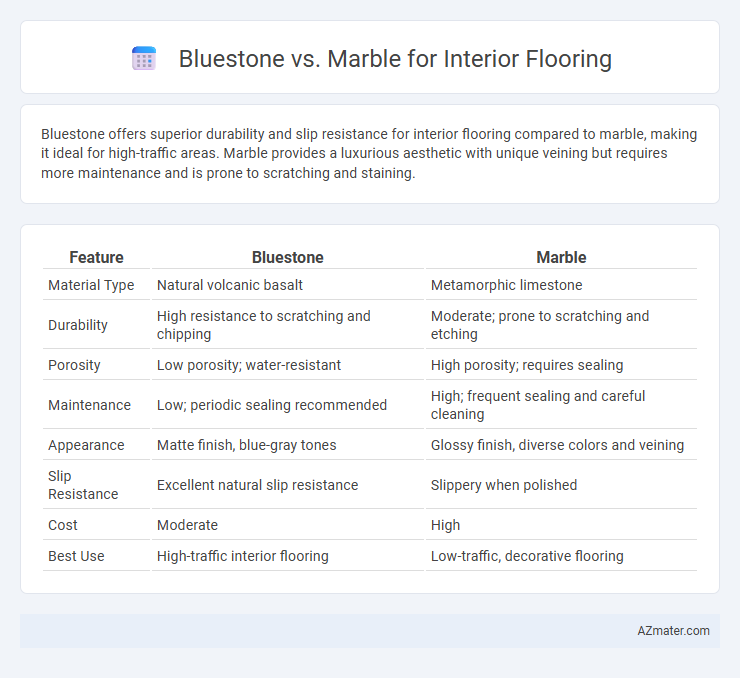Bluestone offers superior durability and slip resistance for interior flooring compared to marble, making it ideal for high-traffic areas. Marble provides a luxurious aesthetic with unique veining but requires more maintenance and is prone to scratching and staining.
Table of Comparison
| Feature | Bluestone | Marble |
|---|---|---|
| Material Type | Natural volcanic basalt | Metamorphic limestone |
| Durability | High resistance to scratching and chipping | Moderate; prone to scratching and etching |
| Porosity | Low porosity; water-resistant | High porosity; requires sealing |
| Maintenance | Low; periodic sealing recommended | High; frequent sealing and careful cleaning |
| Appearance | Matte finish, blue-gray tones | Glossy finish, diverse colors and veining |
| Slip Resistance | Excellent natural slip resistance | Slippery when polished |
| Cost | Moderate | High |
| Best Use | High-traffic interior flooring | Low-traffic, decorative flooring |
Introduction to Bluestone and Marble Flooring
Bluestone flooring, a durable and dense natural stone, features blue-grey hues with a subtle texture ideal for modern interiors requiring both elegance and resilience. Marble flooring offers a luxurious, polished surface characterized by distinctive veining patterns that enhance classic and contemporary spaces with timeless beauty. Both materials provide unique aesthetic and functional qualities, influencing choices in interior flooring based on style preference, maintenance needs, and durability.
Key Material Characteristics
Bluestone offers exceptional durability and slip resistance, making it ideal for high-traffic interior flooring, with a natural cleavage surface that provides texture. Marble is prized for its elegant veining and smooth, polished finish, offering a luxurious and sophisticated aesthetic but is softer and more prone to scratching and staining. Both materials require proper sealing, but bluestone generally demands less maintenance, while marble's porous nature can necessitate more frequent care to preserve its appearance.
Aesthetic Appeal: Color and Texture Comparison
Bluestone features a natural, earthy palette with shades ranging from deep blues and grays to subtle greens, offering a matte, slightly textured surface that enhances a rustic or modern aesthetic. Marble provides a polished, high-gloss finish with a classic color spectrum including whites, blacks, and rich veins of gold or green, creating an elegant and timeless look. The contrasting textures and colors of bluestone and marble influence interior flooring choices by balancing durability with distinctive visual appeal.
Durability and Longevity
Bluestone offers superior durability with high resistance to chipping, cracking, and wear, making it ideal for high-traffic interior flooring. Marble, while elegant and timeless, is softer and prone to scratching and etching, requiring more maintenance to preserve its longevity. The natural density and hardness of bluestone contribute to its extended lifespan compared to marble in interior applications.
Maintenance Requirements
Bluestone flooring demands regular sealing and prompt stain removal to prevent discoloration and surface damage, especially in high-traffic areas. Marble requires routine polishing and careful cleaning with pH-neutral products to maintain its natural luster and prevent etching from acidic substances. Both materials benefit from periodic professional maintenance to extend their durability and aesthetic appeal in interior settings.
Slip Resistance and Safety
Bluestone offers superior slip resistance compared to marble, making it a safer choice for interior flooring in areas prone to moisture. Its naturally textured surface reduces the risk of slips and falls, ideal for homes with children or elderly residents. Marble, while elegant and smooth, tends to be more slippery and requires additional treatments to enhance safety on polished floors.
Installation Complexity
Bluestone installation for interior flooring requires specialized cutting tools due to its dense, layered structure, making it more labor-intensive and time-consuming compared to marble. Marble offers easier installation with smoother surfaces and uniform thickness, facilitating quicker setting and polishing. Proper subfloor preparation is crucial for both materials to prevent cracking, but bluestone demands extra care for sealing to maintain durability and appearance.
Cost Considerations
Bluestone flooring typically costs between $5 to $10 per square foot, making it a more budget-friendly option compared to marble, which ranges from $10 to $30 per square foot depending on the grade and origin. Installation expenses for bluestone can be lower due to its durability and ease of cutting, while marble often requires specialized labor, increasing overall project costs. Maintenance also affects long-term expenses; bluestone's resistance to stains reduces upkeep costs, whereas marble demands regular sealing and careful cleaning to preserve its appearance.
Environmental Impact
Bluestone offers a lower environmental impact than marble due to its abundant natural availability and less intensive quarrying process, which reduces carbon emissions. Marble extraction involves more energy consumption and generates significant waste, contributing to greater ecological disturbance. Choosing bluestone supports sustainable interior flooring options by minimizing carbon footprint and resource depletion.
Best Applications for Each Material
Bluestone is ideal for high-traffic areas and outdoor extensions due to its durability, slip resistance, and natural, rustic appearance, making it perfect for patios, hallways, and kitchens. Marble excels in low-moisture, indoor environments where elegance and sophistication are desired, such as living rooms, bathrooms, and formal dining areas, thanks to its smooth, polished surface and wide range of color options. Choosing bluestone or marble depends on balancing durability needs with aesthetic preferences, ensuring long-lasting beauty and function in your interior flooring.

Infographic: Bluestone vs Marble for Interior Flooring
 azmater.com
azmater.com